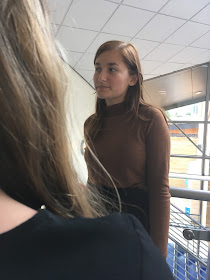Hello! To refresh our knowledge of camerawork, we explored the main shots and angles we could use in filming an opening sequence. Some examples with explanations are here:
High angle shot
This shot is taken from a high angle at the top of the stairs, so in theory it doubles as an establishing shot and a high-angle shot. This angle is often used in films to show inferiority of a character, to symbolise how small they feel or to show that the odds are stacked against them.
Over the shoulder shot
This is a type of over the shoulder shot which would be used in a conversation scene, as it shows both characters but focuses on the expression of emotion in one character's face. As we have done in this example, the shoulder itself is often not in focus, so that the opposite character can be seen more clearly and to create a professional feel of the whole shot. Over the shoulder shots are often reversed and repeated to create a 'shot-reverse-shot' of the entire conversation. This helps with fluency and also keeping the shots varied, helping with audience engagement.
Close up shot
These shots, because of the proximity to the face, are often used in film to show emotion without using dialogue. It is closer to the actor than a mid shot, which includes the elbows/waist, but further away than an extreme close up, shown below. When cut with another shot of an object or person, the audience is led to believe the character is looking at the object/person or wants to interact with it.
Extreme close up
These shots are also used to show emotion, but it usually focusses on one facial feature which is almost disturbing for an audience as it is unnatural. An effective use of this shot would be in the thriller/horror genres, as a zoom on an eye can connote fear and anguish to the audience.
Bilateral symmetry shot
This example is obviously quite comedic, as our poses are relatively cheesy! The bilateral symmetrical shot is aesthetically pleasing as there is perfect symmetry on each side of the shot, but also has a quite eerie feel so may feature in sci-fi or horror films.
Dutch tilt angle
This camera angle may often be used in thriller or horror films, as it creates tension and is quite an unorthodox angle to use. It adds variety to the shots which can keep the audience engaged in the film or text, and is interesting to analyse as it is likely the director would have used this angle for a reason.
Establishing/Long shot
This shot establishes the setting of the scene and films often open with this type of shot to establish setting of the whole film, such as a high school movie. An extreme long shot or wide shot may also be used to open a film, such as a drone or helicopter shot to establish a city setting.







No comments:
Post a Comment